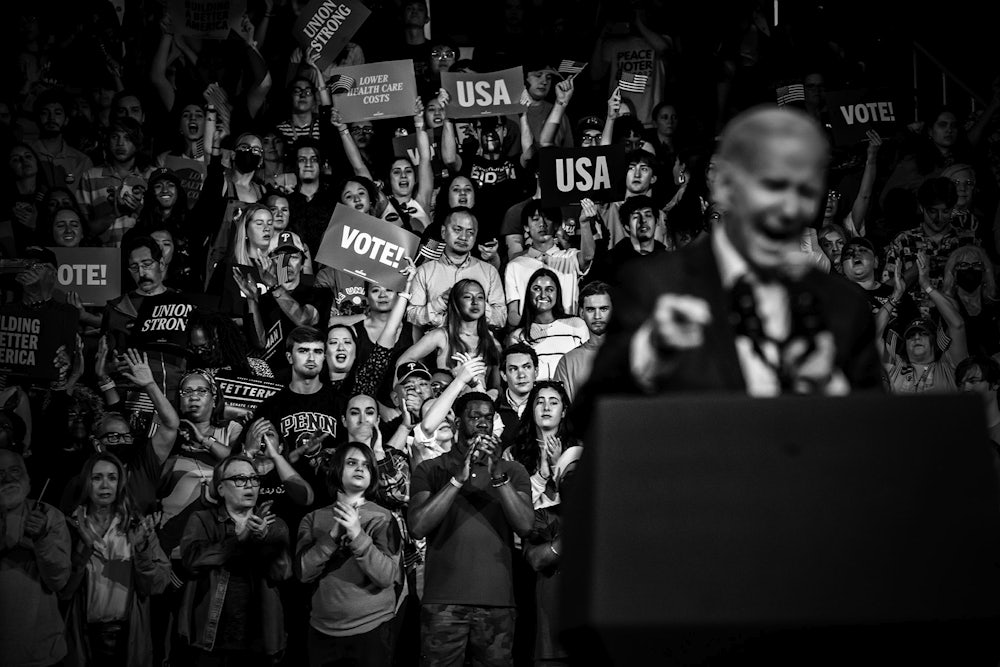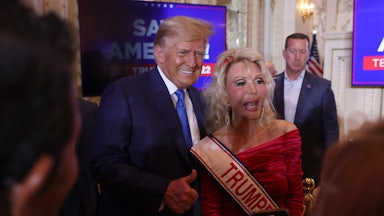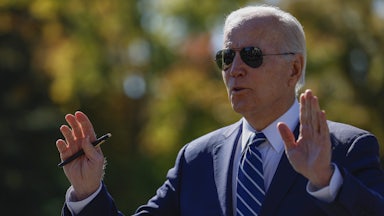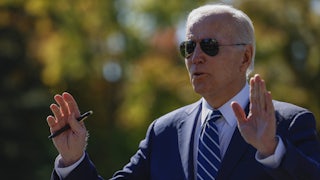The morning after Election Day, How to Save a Country hosts Michael Tomasky and Felicia Wong looked at how progressive ideas—particularly progressive economic ideas—fared throughout the country. On episode 8, they discuss why we might be in a new era of midterms, what the media got wrong about election narratives, what political ads can tell us about economic policy, and whether elected officials can connect the dots between rhetoric and reality.
How to Save a Country is presented by the Roosevelt Institute, The New Republic, and PRX. Generous funding for this podcast was provided by the William and Flora Hewlett Foundation and Omidyar Network. Views expressed do not necessarily reflect the opinions and beliefs of its funders.
Michael Tomasky: I’m Michael Tomasky, editor of The New Republic.
Felicia Wong: And I’m Felicia Wong, president and CEO of the Roosevelt Institute.
Michael: This is How to Save a Country, our podcast on the ideas and the people contributing to a new political vision and a new economic vision for the United States. We connect the economy, democracy, and freedom.
Felicia: Because progressives need a common purpose and a common strategy to win.
Lauren Blanchard [clip]: The nonpartisan group Open Secrets estimates these midterm elections have cost a record-breaking 16.7 billion across state and federal races.
John King [clip]: Just look at this map. That’s not a red wave. That’s nothing like a red wave.
Symone Sanders-Townsend [clip]: So for all the people that said all these things about young people across America—they didn’t care, they weren’t gonna vote. Young people are showing up in key places, and I think it’s gonna be a story we talk about going forward.
Michael: Felicia, here we sit, we’re recording this the day after the midterm elections.
Felicia: We don’t have a guest. We are each other’s guests. We’re doing this, I’m doing this as the head of the Roosevelt Institute. And the Roosevelt Institute is a 501(c)3, which means that we are going to be talking today more about the policy than about the politics, which might let us tell some interesting stories but also constrains us a little bit.
Michael: Well, a little bit, but it’s in keeping with the spirit of the show, anyway. We’re going to talk about the role that economics played in this midterm and where things might be headed over the next two years.
Felicia: That’s the big surprise, how economics have played out in this election cycle.
Michael: We’re just gonna start with the obvious observation, which is, of course, that the party empowered normally loses a lot of seats in these elections. The average since 1934 is 28 seats, and it’s been more dramatic than that in recent years. Barack Obama lost 63 in 2010. Back earlier than that, in 1994, Bill Clinton lost 54 seats, and Donald Trump, in 2018, lost 41 seats. Joe Biden is going to lose far fewer than that.
Felicia: That’s what it looks like, right?
Michael: Yeah.
Felicia: This is also a scary election cycle. In some ways it even threatened to be what I sometimes think of as a perfect storm election because there were so many election deniers who were running for office. There were a lot of cybersecurity threats. And a lot of races still aren’t called; it’s not clear what will happen next. It’s not clear who will challenge election results. But we’ve also seen many candidates concede already, which—maybe this will be a “normal” election.
Michael: Whatever normal is.
Felicia: Yeah. Right. Just to set the table here, there are some real surprises with respect to policy. There wasn’t that red tsunami that many in the media predicted, but even more than that, from an economic perspective, there was maybe this hint, in some of the way candidates talked about the economy, that you can actually run and build real momentum on an economic agenda that’s kind of a “Build it, we can thrive, we can have public investment in new economic sectors,” the kind of stuff we’ve been talking about on this podcast. Well, some people actually ran on that, and they seemed to do pretty well.
Michael: Another observation that I would make about this election is that I feel that we’ve moved into a new era in midterm elections in this country. Turnout was 49 percent in 2018, which was the highest for a midterm since 1914. I took note of that at the time and I thought, well, “Is this a one-off just because Donald Trump’s in office, or is this our new normal? Is this our new reality?” I haven’t actually looked at the turnout figures yet, but it’s up there, and we’re now in a new, really hard-fought, toe-to-toe era of midterm elections. Thirty years ago, a lot of people didn’t vote in midterms. And those who voted kind of voted on, well, “Do I like the incumbent?” Midterms weren’t nationalized. Now, of course, they’re totally nationalized. They’re totally polarized. We have a country that I would describe as a 47-47-6 country.
Felicia: What do you mean?
Michael: Forty-seven percent Republican, 47 percent Democrat. No matter who the candidate is in whatever congressional district, it’s 47–47, and then there’s six roughly in the middle. In some districts and states, it’s a little larger, in others it’s a little smaller. But I would say, national average, it’s around a 6 percent portion of the electorate that can vote for either party, that is still genuinely swing voters. So that’s where we are, and I think that’s where we’re gonna be for the foreseeable future. And the point now is to get as much of that 47 percent out as you possibly can on both sides and then win 3.1 percent of the remaining 6 percent. And that’s going to be the formula.
Felicia: You mean 51 percent of the remaining 6 percent, but yes, yes, I know what you meant. I do think it obviously changes district by district and congressional district by congressional district and state by state. But I think your larger point is that these are nationalized elections, even the midterms, not the presidentials, but even the midterms, and that the electorate has become really calcified with a very few people who actually can be persuaded. I still think that what Deepak Bhargava said to us a few episodes ago about asking more people to participate, and how persuasion is important to progressive politics; I still think that’s true, or I still think that’s possible, anyway, but I think your point about 47-47-6 is also really right.
Michael: Yeah.
Felicia: Let’s get into talking about the economics and economic policy as it played in this election cycle. Our amazing producers have put together some clips of how people were talking about the economy in 2022.
Hilary Rosen [clip]: When voters tell you over and over and over again that they care mostly about the economy, listen to them. Stop talking about democracy being at stake.
Chris Christie [clip]: They’re talking about inflation, and they’re talking about crime. And those are really the only two issues I’ve heard voters talking about. ’Cause those issues are ones that Democrats have been uncomfortable talking about. They’re more interested in talking about abortion and about threat to democracy.
James Carville [clip]: I would criticize Democratic messaging and the media for letting people go to the polls with massive misunderstanding of what the consequences of the vote are.
Felicia: That was a lot of pundits, Michael, and as you can hear from that, the Democrats really walked into Tuesday’s election with a lot of hand-wringing. My dad used to call it “woulda, coulda, shoulda.” Like, “should have done that, would have done that.” And it’s just a lot of uncertainty about how to talk about the economy and also, of course, Republicans assuming that Democrats were wrapped around the axle because of inflation and because of the economy—they were kind of rubbing their hands together in presumptive glee. So that was the mood.
Michael: Yeah, but then we got the results, and the results demonstrated that, first of all, the media narrative developed over the course of the last two months of the campaign—that the Democrats only talked about abortion and didn’t talk about the economy at all. But that really wasn’t true. I wrote a column that went into this a little bit, and others wrote about it as well. The Washington Post actually did a huge analysis of how much money Democratic candidates were spending on different topics, and abortion was number one for sure. And who’s to say that was wrong?
Felicia: The exit poll suggests that that was not.
Michael: Yeah, right. So that was number one. But they certainly spent millions of dollars in ads trying to tout the economic accomplishments. And the economic accomplishments were there, you know: the job growth—nearly 11 million jobs in two years. That’s almost without precedent, I think, among any postwar president[s]. Wage growth, sluggish at start, but picked up more recently; GDP numbers, quite strong. They did have a bit of an economic story to tell. Now obviously it was all overwhelmed by inflation, and the Republicans spent most of their money, TV ad money, talking about inflation and the Democrats’ big-spending ways ruining the economy. So it was a sort of a match between those two arguments and kind of a draw.
Felicia: Kind of a draw, but also what I found most interesting about the ads that I was watching—because I was listening, of course, for these other arguments about the economy—and a couple things in what I listened to, first of all, I think that a lot of frontline Democratic candidates (meaning Democratic candidates in very tight races), a lot of their ads were about jobs: job creation, what it means to be in the working class. And I think somebody like Matt Cartwright, who was a candidate in Pennsylvania, his ads really showed me that he was fighting to show that he was part of, and working for, the working class.
Matt Cartwright [ad]: You know, Marion and I have lived in Northeastern Pennsylvania the last 34 years. We raise our family here. And that whole time my opponent wasn’t here. He was off being a lobbying executive, pushing tax cuts for the rich, cuts to Medicare and Social Security. I’ve been here fighting against corporate greed, fighting for working people. I’m Matt Cartwright, and I approve this message. I work for you.
Michael: See, the interesting thing about that ad to me, Felicia, is that he named an enemy.
Felicia: Corporate greed.
Michael: Corporate greed. And said, “I work for you.” Now, this is something that a lot of Democrats don’t do. They like to do aspirational. A lot of them shy away from doing confrontational. And you know, people know you by what you’re for, but they also know you by who you’re against, you know? And any story needs a villain. You know, name me a Disney movie that doesn’t have a villain.
Felicia: Oh, that’s what Dorian Warren said when we talked to him. He said, “I’m for working people, and I’m against corporate greed.” That’s a pretty clear jobs-and-worker message, if you ask me. The other thing I really noticed was that a lot of frontline Dems also ran on this thing we’ve been talking about, Michael—industrial policy. Brian Deese talked about that in our very first episode. It’s all of these policies that are designed to put public money back into the economy so that you could build new sectors of the economy: everything from manufacturing to wind farms. This was really about bringing jobs back home. And what was interesting to me is that you saw lots of candidates in embattled districts, people like Abigail Spanberger in Virginia to Sharice Davids to even the Virginia Republican Jen Kiggins, talked a lot about bringing jobs back home and investing in American manufacturing.
Michael: Spanberger was particularly interesting to me, and she won by about four points.
Felicia: That was not a given going into this.
Michael: Not at all. So there are a few things to say about that race. Back in 2021, she got a lot of heat, including from me, by saying—this is at a time when Build Back Better was stalled and Manchin and Sinema were up to whatever it was they were up to.
Felicia: I remember those days, Michael.
Michael: Yes, I’m afraid we all do. She said something like, “Nobody elected Joe Biden to be FDR.” I wrote a column that said, “Well, that’s probably true in the 7th district of Virginia, where you live. But I can say that in the whatever-numbered district of Maryland where I live, which is Jamie Raskin’s district, everybody I know elected him to be FDR. And it was interesting. It was an—
Felicia: My heart. Michael is a card-carrying Roosevelt, but yes, keep going.
Michael: Right. But it was an interesting … I’m sure she was speaking the truth from her perspective, but I bet she came away from that episode maybe rethinking things a little bit. Because at the end of this campaign, she spent the closing weeks going around the district touting projects that were brought there by the infrastructure bill. So you know, far from running away from her party’s economic and industrial agenda, she seemed to embrace it toward the end.
Felicia: Right. Well, let’s not forget, the infrastructure bill and the CHIPS and Science Act—both of which I think she talked about on the trail—those were actually bipartisan. So she could do that perhaps safely, even in a dangerous district—a dangerous-to-her district—but it is notable that she spent so much time talking about industrial policy.
Michael: Yeah.
Felicia: And then the other thing I think is so interesting: You mentioned that Washington Post article that did a detailed analysis of where Democrats and Republicans were spending money in their advertising. Republicans, as it turns out, spent most of their money on anti-tax ads, even more than on anti-inflation ads, and even more than on crime ads. That was really surprising to me, and most of it was anti-IRS. Here’s one example from Nicole Malliotakis.
Campaign ad [clip]: It seems like a Hollywood movie, but with Biden and Max Rose, it’s the new reality. A financial war waged on middle-class families. The first assault: a massive tax increase. Then billions spent to build an army of IRS agents unleashed on families like yours. Thanks to Max Rose and Biden, you might be hearing a knock at your door very soon.
Nicole Malliotakis: I’m Nicole Malliotakis, and I approve this message.
Michael: Yeah, well, they’ve been building up hatred of the Internal Revenue Service on that side for decades now: ads about how evil the IRS is and about taxes and “We’re gonna cut your taxes.” I think it just proves the point that I’ve made from time to time on this podcast, Felicia, that neoliberalism isn’t dead, that it’s basically what they have to run on. And they don’t have a whole lot of other ideas.
Felicia: We are probably going to see more of this because of course the Inflation Reduction Act included $80 billion to reform and strengthen the IRS. But the reason that policy did that is so the IRS could actually do audits properly on wealthy people, because that is one of the biggest problems with the IRS: It doesn’t collect all the taxes that Americans even owe under the current law because it doesn’t have enough expertise in auditing the very, very wealthy. Now that is actually quite popular, as are tax increases on the wealthy and corporations. So I think we’re going to see taxation as a real site of contestation for a long time to come, Michael. But maybe some of those politics have shifted, given that people want to raise taxes on the rich.
Michael: Yeah. And if the Republicans do capture the House by whatever margin, they’re going to push to do away with that Inflation Reduction Act funding for the Internal Revenue Service. So we’ll have a good old legislative fight to watch and see how that plays out.
Felicia: So Michael, that’s a lot about ads, but we also know something about this election, even just a day or so after, by looking at the exit polls. What did they tell us?
Michael: They told us that a bunch of media narratives were wrong. There was a media narrative that—
Felicia: How shocked are you as a journalist?
Michael: Terribly. Yeah. So narrative one: Independents and moderates were going to break for Republicans. That didn’t happen. There were two sets of exit polls, one from the Associated Press and one done for the television networks, and both of those showed very narrowly—and there’s a lot of guesswork in these exit polls these days, so I would not say they were precise, but they’re all we have and we have to go by them—they showed that independents went narrowly for Democrats. There was also a media narrative that Latinos were going to abandon the Democrats and go to the Republicans. That didn’t happen.
Felicia: Isn’t it still true that the Latino vote is much more swingy than it was 10 years ago?
Michael: Yeah, but it’s gone back and forth. I mean, George W. Bush in 2004 got 42 percent of the Latino vote. That was a high-water mark. According to these exit polls, it was around 60–40. Sixty–thirty-nine in one and 56–38 in another. Still, there was a media narrative that Latinos were abandoning the Democratic Party. So that also was wrong. And then there was also a media narrative that voters didn’t care about abortion, didn’t care about Dobbs, that was no longer a voting issue.
Felicia: That one never made sense to me, but you did hear it in the final weeks. And what do we learn from the exits?
Michael: Well, one of the two exit polls had inflation as the number one issue, at 31 percent level of concern, but abortion a close second, at 27 percent. And then we see that those statewide referenda on abortion rights were supported by voters in five different states, including Kentucky and Montana. So I think abortion probably mattered after all.
Felicia: Well, that is probably for a lot of reasons, including turnout that you’ve seen from women. So Michael, we’re going to talk in a minute about where all this is going to head, but first, I think it’s time for a quick break.
Dan Balz [clip]: People are angry at the state of the country, in the direction of the country. They’re fearful about where the country is. It doesn’t matter if they’re Democrats or Republicans, in one way or another they have grievances. They are suspicious of the other side, of people in the other party. They are concerned about their own well-being.
Felicia: Well, Michael, what do you think about that? That kind of gets back to what you were saying earlier in the show, this 47–47 politics, highly calcified, very protective and pretty fear-based, and that’s certainly part of what we have seen in this election. The question, though, is whether there’s anything that could be more optimistic, more visionary, in our politics going forward. Have you seen any signs of that from this midterm?
Michael: Sort of. I haven’t seen any data yet that would—
Felicia: Well, it’s pretty early.
Michael: Pretty early. I haven’t seen any data yet that supports the idea that voters went out there and voted affirmatively for the Biden economic vision. I think that would be overstating it. I would put it this way, though: While it’s not clear that Biden’s legislative wins helped, I do think it’s clear that they didn’t hurt.
Felicia: In what way would you have thought that they would have hurt? How would that story have played out?
Michael: Well, you know, “This is socialism and big spending and typical free-spending liberals who caused inflation with all their crazy socialism.”
Felicia: Right.
Michael: Which is what was said, but it didn’t result in—again, we don’t know exactly why people voted the way they voted, but we don’t have an end result of a 50-seat Republican switch.
Felicia: So I guess what you’re seeing is that that sort of “American Rescue Plan caused inflation” hand-wringing that we’d sort of worried about, many pundits had worried about coming into the election—that didn’t actually play out. And what that brings to mind is actually the 2010 midterms. That was that election where the Democrats, led by Barack Obama, lost so many seats that Obama himself called it “the midterm shellacking.” And what was so interesting about that election is that then those exit polls said that only about a third of the voters thought that the economic stimulus helped the economy. Obama himself really recognized that, because he said right after that election, If right now we had 5 percent unemployment instead of 9.6 percent unemployment, then people would’ve had more confidence in our policy choices. So I think we’re in a really different place now than we were in 2010, Michael. That people know that actually this economy is not losing jobs. They also obviously know that it’s an inflationary economy, but I think they recognize the jobs piece. And while it’s hard to prove a counterfactual, I do think that 2010 comparison is notable.
Michael: It is, and you know, 10 and a half million, 11 million jobs—that’s a lot of jobs in the space of two years. I have to think that people notice that kind of stuff in their communities. And I’ve also seen a lot of stories in recent weeks, after the passage of the CHIPS Act, where they’re building a new factory in such-and-such town, partly or wholly as a result of that act. That gets on the local news. That’s a big deal when there’s a new factory being built somewhere. And people know that, and they understand that it has something to do—I hope they understand it has something to do—with this act. And I think there’s a lot of infrastructure work going on around the country. I drove recently from where I live, outside of Washington D.C. to Columbus, Ohio. Normally a six-hour drive, and it took about eight and a half because of all the construction, which made me kind of grumpy. But it also made me realize: This is hard infrastructure bill construction going on. So I think on some level people are seeing in their lives that this legislation is actually doing some things.
Felicia: Well, Michael, I hope that as you were driving down that highway, you saw giant signs that said, “Brought to you by the federal government.” OK, you’re laughing. That means you didn’t see that. Which suggests to me, though, that there is just a lot more runway to connect the dots for people, right? To tell the story that federal spending is why you might see improvements at your local airport. It is why you might see new factories in your town or in your communities. We know—from the exit polls and from what very knowledgeable pollsters will tell us—that most people just do not know the story of the CHIPS Act, the Inflation Reduction Act, or the Infrastructure Act. They just don’t know. So what all that says to me is that elected officials, politicians, need to connect the dots between what they do, the laws that they pass, and what happens in people’s real lives. There’s just a lot more runway to tell that story.
Michael: Heading into 2024, I think there is a chance to tell a story about all that that’s positive. Inflation needs to recede; that’s a given, because as long as it’s high that remains the dominant story in the media. But there seems to be—from the economists I pay attention to—good reason to think that inflation will recede.
Felicia: It’s been a long couple of weeks. It’s been a long night of continually refreshing our browsers to find out what the latest election results are, so we could even do this podcast and, of course, be informed citizens of our country. But with all that, Michael, what are your final thoughts here?
Michael: Well, I’ll circle back to what I said earlier about 47–47–6, but I’ll elaborate on it like this: There are millions and millions of Americans out there who want a multiracial democracy that is a just and reasonably progressive society. I think the election demonstrated that those people are out there.
Felicia: When I woke up this morning and looked at the results such as they were, as of, you know, 6 a.m. or whatever, the day after a very contested election, I thought the same thing. Like, “Wow, people are coming out actually in favor of something that looks like democracy. They are making their voices heard. They are voting for things they care about like abortion rights. Young people are coming out.” That’s what I thought when I woke up this morning. So I agree with you that there are many signs in this election that suggest that it’s not just us, Michael, who want our country to be saved. And then I will go back to what many of our guests have said, which is if you’re going to build more of a set of alliances or coalitions of people who want the kinds of policies that we want—who want more equity, want more racial inclusion—you gotta go out and ask people to take action. And that’s what I think I saw, maybe, in these midterms election results.
Michael: I’m with that.
Michael: How to Save a Country is a production of PRX in partnership with the Roosevelt Institute and The New Republic. Our coordinating producer is Cara Shillenn. Our lead producer is Alli Rodgers. Our executive producer is Jocelyn Gonzalez. And our mix engineer is Pedro Rafael Rosado.
Felicia: Our theme music is courtesy of Codey Randall and Epidemic Sound with other music provided by APM. How to Save a Country was made possible with support from Omidyar Network, a social change venture that is reimagining how capitalism should work. Learn more about their efforts to recenter our economy around individuals, community, and societal well-being at omidyar.com.
Michael: Support also comes from the Hewlett Foundation’s Economy and Society Initiative, working to foster the development of a new common sense about how the economy works and the aims it should serve. Learn more at hewlett.org.
Felicia: We’ll be back in a week with another episode on—what else?—how to save a country. So if you’re not following the podcast yet, please do so.
Michael: And, of course, throw us a rating or a review.








